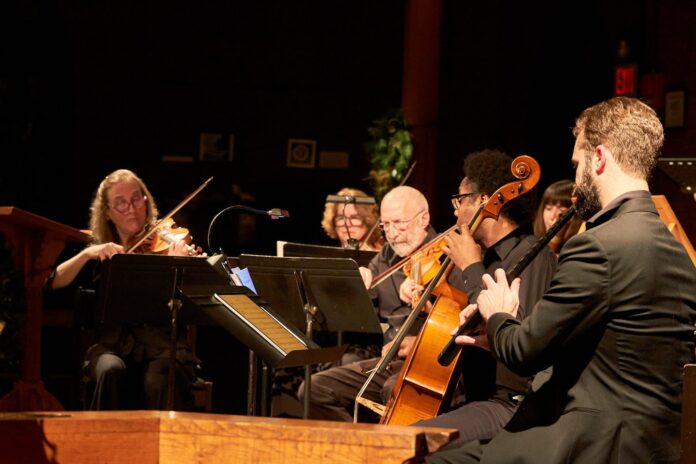On paper, the consort is the resident early music ensemble of the Folger Shakespeare Library, specializing in repertoire drawn from the medieval, Renaissance and Baroque periods.
But, in practice, the Folger Consort is essentially a good-time band — a high-energy ensemble of big smiles and talents who play their delicate instruments with ardor and intensity. In the grand context of a Christmas celebration, the limits and imperfections of the ensemble only serve to ramp up the human nature of the music. As a listener, it makes you feel more … mere?
To open and anchor this Christmas celebration, artistic directors Robert Eisenstein and Christopher Kendall selected Heinrich Schütz’s “Weihnachtshistorie.” Compact by Nativity standards, and a relative deep cut among more familiar holiday music offerings, the 35-or-so-minute oratorio (probably first performed in Dresden in 1660) also stands apart for its generous musical variety and operatic delegation of roles — the way the shepherds are summoned by lithe recorders and trombones herald King Herod.
The tale is split across a septet of singers who move in and out of solo, trio (i.e., shepherds and wise men) and ensemble passages.
Soprano Agnes Coakley Cox took several sufficiently angelic solo turns, her “Der Engel Zu Joseph” a particular highlight of her control and ease. The smooth, unadorned tenor of Haitham Haidar was wonderfully suited to his narrative duties as Evangelist. Bass Paul Greene-Dennis lent lovely texture to trios with tenors Aaron Cates and Bradley King (though the three came unglued now and then in the concert’s second half).
Mezzo-soprano P. Lucy McVeigh and alto Jamet Pittman also gave strong performances — though I found myself occasionally losing touch with them and the other singers, and wishing the whole lot of them weren’t stuck behind their fellow musicians.
After an intermission, the string players set up behind us in the rear nave for a performance of Estonian composer Arvo Pärt’s “Fratres” — a particularly crystalline example of his “tintinnabulation” works, which have to them the overlapping, layering, resonating unison of bells. (In the program, Pärt’s wife, Nora, is quoted as describing the approach as “1+1=1.”)
It was an uncanny stretch of simulated stillness, the sound of the invisible ensemble seemingly emerging from our thoughts, its glow brightening and halting like an ember. Violinist and viol player Risa Browder, cellist Wade Davis, violist Nina Falk and Eisenstein (who throughout the night moved between violin, recorder and even some singing) made a fine string section all evening. But this interlude — programmed at the insistence of Kendall, who also leads the 21st Century Consort — was an especially poignant transposition of Pärt’s work to the Folger’s hand-hewn vibe.
The consort took a break in the program to offer a quick tour of a handful of early instruments. Nathaniel Cox toggled throughout the night between his theorbo (an extremely long-necked lute) and the mythic-seeming cornetto, a hybrid of wind and brass, with the body of a flute (often made of either hardwood or bone) and the mouthpiece of a trumpet. Its warm, singing tone was crafted to complement the human voice, and Cox masterfully tapped this aspect in his playing.
Anna Marsh also played double duty on recorder and bass dulcian — a sizable bassoon-esque wind instrument of which Marsh’s constitutes a smallish specimen. Paula Maust demonstrated her chamber organ, its electric blower replacing a manual pump — as well as the small legion of choir boys once required to operate it.
And trombonists Dan Meyers and Eric Kernfeld shared their knowledge of (and strong feelings about) the sackbut — or saqueboute, or shagbolt, or shakbusse — a Renaissance brass instrument with slightly different mechanics than a modern trombone, as well as a mellifluous tone that curls around the voices of the singers it accompanies.
This spotlight seemed to polish the instruments for the centerpiece of the program’s second half, a suite of songs by Schütz’s slight elder, Michael Praetorius. A piquant trio of late Renaissance bangers comprise the “Dances From ‘Terpsichore,’” — a “Ballet de la Comedie,” a sprightly courante, and a “Volte de Tambour” that put the recorders through their paces. It was a fabulous instrumental break, and a tantalizing sample of the composer’s lost troves of secular music.
Of course, Praetorius is best known for his hymnal settings, of which we heard four — the last of which, “In Dulci Jubilo,” was delivered in four settings of its own. Most impressive were the neighboring “Es ist ein Ros entsprungen” (“Lo, how a rose e’er blooming”) and “Psallite,” each with wonderful ensemble singing and intricately detailed instrumentation.
Perhaps as enjoyable as the music itself was the pleasure the consort took in playing it. When he wasn’t playing or singing along, Eisenstein often leaned back in his seat, eyes closed, head tilted to the church’s arches, blissing out. It’s a contagious energy — and one that feels especially useful in a season where a little humanity goes a long way.
(One necessary admonishment, unrelated to the performance itself: If, at the outset of your program of European music, you dispatch a “visitor service experience expert” to recite a land acknowledgment statement, the even barer minimum is to learn how to properly pronounce the name of the tribe you are “acknowledging and engaging.” The prolonged live mangling of the Nacotchtank people’s name was an absolute car crash, and an ugly note to overcome before the music had a chance to begin.)
A Baroque Christmas Story repeats through Dec. 22 at St. Mark’s Episcopal Church. Tickets at folger.edu/programmes/folger-consort.



